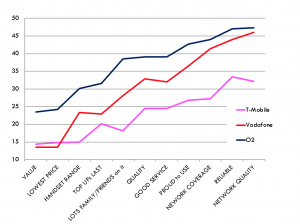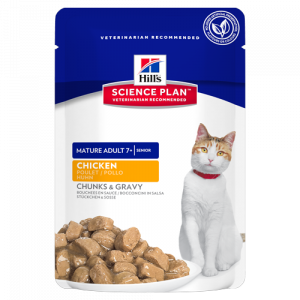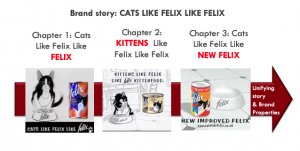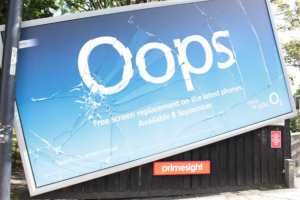In a recent brand-led innovation project, we discussed Mark Ritson’s latest column that has added fuel to the fire of debate about distinctiveness versus differentiation (1). “There is a worrying trend to favour distinctiveness over differentiation,” he said. “You need differentiation. A few non-unique but important associations can be claimed by a brand … to stand out and pull in customers.”
The distinctiveness trend referred to is of course driven by Byron Sharp, whose views I first posted on here, back in 2011. “We question the importance of differentiation and instead place distinctiveness at the centre of brand strategy,” stated Byron in one of his papers (2).
So, who is right?
To answer this question, we need to clarify what we really mean by ‘differentiation’.
1. Leading brands are more famous
The traditional view of differentiation is to stand out on one or two key attributes: to be ‘the fastest’ or ‘the most caring’, for example.
However, brand strength (or weakness) tends to occur across the board, not on one or two attributes.
You can see this in the brand image data from the UK mobile network market below. Notice also how the shape of all three image profiles is quite similar (all three brands score higher on network and lower on value, for example):
- O2 is the strongest brand across all attributes
- T-Mobile is the weakest brand across most attributes
- Vodafone is in the middle across most attributes
Some of O2’s image scores are slightly higher than you would expect given its overall strength (e.g. lowest price +3) and others are slightly lower (e.g. reliable -4). But these differences are small. So, O2 is not differentiated in the traditional sense.
I suppose you could argue that it has something like ‘holistic differentiation’: a stronger image across the board. ‘Brand fame’ is perhaps a better way of describing this.

The data above is only for one market. But similar results have come up time again on brandgym projects. And an extensive study of 17 categories by Byron Sharp showed that only 17% of brand users thought their brand was unique or different (2).
 2. Distinctiveness drives brand fame
2. Distinctiveness drives brand fame
So how do you achieve the sort of holistic image strength of a leading brand like O2?
Yup. You guessed it. This is where distinctiveness comes in.
Distinctive assets can do much more than just “make a brand look like itself”, which is the role Mark Ritson suggests for them. Distinctive assets can also help communicate the central benefits of a market in a memorable way, if they are ‘loaded’ with meaning over the long run.
O2 has used the ‘blue and bubbles’ brand world for over 15 years to help it communicate attributes such as service and network quality in a distinctive and memorable way. A recent ad shown here uses this visual world to communicate a free screen replacement service proposition.
Another great example we posted on last week is insurance brand Direct Line. The Winston Wolf character, played by Harvey Keitel, has helped the brand build its image on central insurance market benefits such as ‘helpful’ and ‘reassuring’, as Mark points out.
3. True differentiation = niche brand status
But what about differentiation in a true sense, where a brand stands for something genuinely different to the market leader?
This is an approach you can use, provided you are happy with ‘niche brand’ status.
Take cat food as an example. Hills nutrition is a truly differentiated versus leading global brand Whiskas. It has scientifically proven recipes, bag not can packaging, specialist channel distribution and a premium price. As a result, it is a niche brand that is unlikely to grow close to the size of Whiskas.

In contrast, Felix took leadership of the UK cat food market not by having a differentiated offer versus Whiskas. Felix’s claim about cat’s preferring the taste (‘Cats like Felix like Felix’) was close to that of Whiskas (‘Cats would buy Whiskas’). The packaging format, pricing and distribution were also similar.
Instead, Felix grew by communicating the same central market benefit of taste in a highly distinctive way, using the Felix cartoon character and a memorable theme tune. The brand has used the same distinctive assets for an impressive 20 years, as we posted on here.

In conclusion, distinctive assets are key to brand growth and plays a much bigger role than just getting a brand recognised. Over time that can also help drive a brand’s image profile so that it is different and better to the competition.
So, in true consultant fashion, I guess you could say that both Byron Sharp and Mark Ritson are right!
You can see examples of projects to help brands drive distinctive marketing here.
PRACTICAL TOOLS TO START GROWING YOUR CORE
To get some practical help to grow your core business, you can download our Core Growth Driver toolkit by using the form below. This walks you through the 8 core growth drivers we’ve used on consulting projects and in training for leading companies including Mars, Unilever, Mondelez and AB InBev.

We also offer a short, on-demand course on our brandgym Academy platform here. The course is only £95+VAT and is fully refunded if you go on to take the full Mastering Brand Growth program.
Sources:
(1) https://www.marketingweek.com/2018/10/17/mark-ritson-direct-line/
(2) https://byronsharp.files.wordpress.com/2008/04/different1.pdf
Featured image from Percolate
And for other posts on distinctiveness, see below for some suggestions:
FEVER TREE: FIZZING WITH DISTINCTIVENESS:
HAS DORSET CEREALS DESIGN DECREASED DISTINCTIVENESS?
DISTINCTIVENESS CAN EVEN SAVE LIVES: BRITISH HEART FOUNDATION
DISTINCTIVENESS BEATS DIFFERENTIATION FOR NIX & KIX

 2. Distinctiveness drives brand fame
2. Distinctiveness drives brand fame